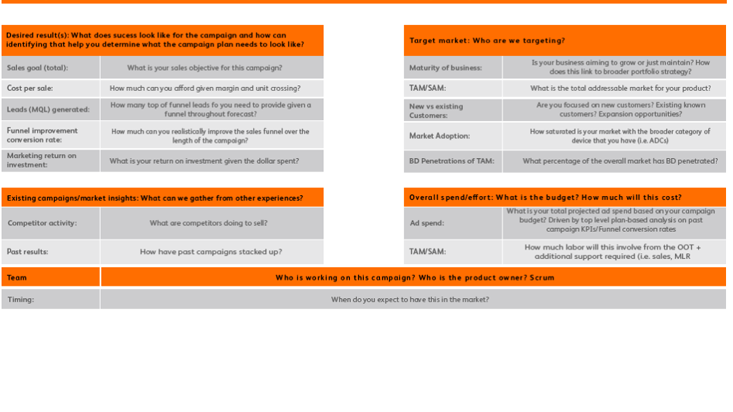Campaign Planning
A sprint based approach to set up a “test and learn campaign” starts already during campaign planning

- Setting Strategic Goals
- Campaign Planning
We recommend using a business case template to outline goals, strategy and tactics for your campaign.
How to use the business case template:

Step-by-Step Guide:

- At the core, OOT oversees the process of campaign planning that begins with defining the campaign's overall goal.

- What are our business objectives, marketing and sales objectives?
- Where in the customer lifecycle is our campaign targeting?
- How does this campaign help me achieve my overall business objective?

- Coordinate with your sales team during the planning phase to align on objectives and consider tactics when planning campaign strategy.

- Define potential strategies to achieve the desired goal of the campaign as initial hypotheses, e.g., align marketing and sales teams more closely through Omnichannel commercial choreography to boost sales generation.

- Once your strategic goals have been defined, build your business case using the campaign planning tool and fill out other dimensions of the template.
Campaign planning begins with understanding the target segments, campaign objectives, and key metrics:
Leverage the Campaign Planning Tool to create a baseline business case for your campaign
There are two versions of the campaign planning tool.
1. For awareness campaigns that focus more on the amount of eyeballs and engagements you get.
Important considerations
- The detailed channel and media plan will be defined and updated by the Digital Marketer.
- The first step is to set the approximate budget, KPIs and performance target for each channel.
- Leverage results from previous BD campaigns and industry benchmarks to define down-the-funnel metrics.
- If you are working with a third-party agency, update your media plan during the media buying phase. The plan can hold the agency accountable for its initial performance metrics.
- Good media plans should clearly lay out the expected budget and forecast performance of each channel based on what metrics you are tracking.
- Utilize the tool to estimate the baseline budget required to reach campaign objectives.
Step-by-Step Guide
The Campaign Planning Tool will be used in different phases of your campaign and should be owned and updated by the Digital Marketer:
The first step is creating a baseline business case, estimating market and potential impact. This step includes defining KPI’s across the engagement funnel.
Think through the following metrics:
Conversion rates:
- Visitor to inquiry
- Forms to MQL
- MQL to SAL
- SAL to SQL
- SQL to Opportunity
- Win
Costs:
- CPC
- Cost per MQL
- Cost per SAL
- Cost per SQL
and see how campaign planning was applied in the section “Campaign Planning”.